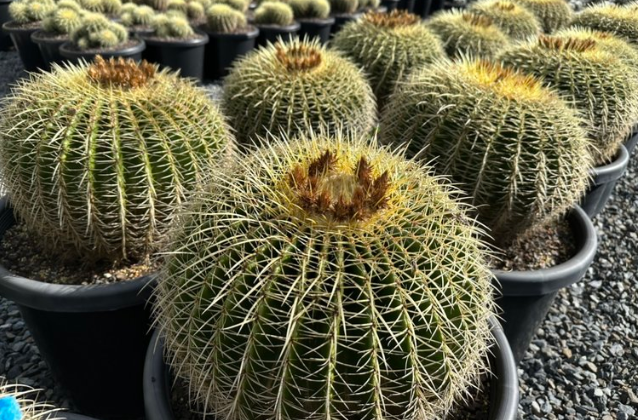Echinocactus grusonii, known as the golden barrel cactus, golden ball or mother-in-law’s cushion, is a species of barrel cactus which is endemic to east-central Mexico. It is found near Mesa de León in the state of Querétaro, and in the state of Hidalgo. The Golden Barrel Cactus features spherical shape and golden-yellow spines. When mature, it can reach sizes of up to three feet in diameter.
Heinrich Hildmann, a notable German plantsman, was the first to formally describe this species in 1891. The specific epithet “grusonii” honors Hermann Gruson, a prominent German industrialist known for his passion for collecting cacti. The golden barrel is considered a rare and endangered species.
In its natural habitat, it often grows in clusters or groups. Like other cacti, this cactus has evolved several adaptations to survive in harsh desert conditions. Its thick, ribbed stems store water, allowing it to withstand extended periods of drought.
While native to Mexico, the Golden Barrel Cactus is grown in many parts of the world as an ornamental plant, in fact, it is one of the most popular cacti in cultivation and has increasingly become popular as an architectural accent plant in contemporary garden designs (commonly used in xeriscaping). This cactus is slow-growing and can take several years to reach maturity.
While commonly referred to as the “golden ball” cactus due to its spherical shape and golden-yellow spines, it’s important to note that there are many other similar-looking species particularly those originating from Brazil and Paraguay, like Notocactus leninghausii which are sometimes referred to as the “golden barrel cactus”. However, unlike Echinocactus grusonii, Notocactus leninghausii features fuzzy, harmless spines.

Physical Characteristics of Golden Barrel Cactus
- Large, roughly spherical globular shape
- Generally solitary, but basal shoots may sprout from adult specimens
- Can reach over 1 meter (3.3 feet) in height and 40 to 80 centimeters in diameter after many years
- Younger plants look different from mature specimens
- Up to 21-35 pronounced ribs in mature plants, not evident in young plants
- Areoles initially yellow woolly, then whitish, and finally greyish
- Long, straight or slightly curved spines in various shades of yellow or occasionally white
- Spines are large and 1 or 2 centimeters apart from each other
- Radial spines arranged in numbers between 8 and 10, measuring more than 3 centimeters in length
- Central spines between 3 and 5, about 5 centimeters long, strong, striated, and straight, with central ones slightly curved downwards
- Small yellow flowers appear in summer around the crown of the plant, typically after twenty years or so
- Flowers are 4 to 6 centimeters long and 3 to 5 centimeters in diameter, lasting only 3 days
- Spherical, somewhat elongated, greenish fruits covered with white wool
- Fruits are 1.2 to 2 centimeters long and contain smooth, shiny brown seeds
Common Uses of Golden Barrel Cactus
- Popularly used for xeriscaping, rock gardens, and desert-themed landscapes.
- It can thrive in well-lit indoor spaces like homes, offices, and commercial interiors.
- It can also be planted in groupings as a mass planting with boulders in rock gardens.
- It can be used as a showy accent in containers with other desert plants.
How To Grow And Care For Golden Barrel Cactus
Light
Provide ample sunlight for your Golden Barrel Cactus. Place it in a location where it receives at least six hours of direct sunlight per day, such as a south-facing window if grown indoors. Outdoors, ensure it’s in a sunny spot with protection from intense afternoon sun, especially in hotter climates.
Temperature
Golden Barrel Cacti thrive in warm temperatures similar to their native habitat. Keep them in temperatures between 70°F to 100°F (21°C to 38°C) during the growing season. They can tolerate cooler temperatures during the winter but should be protected from frost.
Soil
Plant your Golden Barrel Cactus in well-draining soil mix specifically formulated for cacti and succulents. You can also amend regular potting soil with sand or perlite to improve drainage. Avoid heavy, water-retentive soils that can lead to root rot.
Watering
Allow the soil to dry out completely between watering sessions. Golden Barrel Cacti are drought-tolerant and are susceptible to root rot if overwatered. During the growing season (spring and summer), water sparingly, approximately every 2-3 weeks. Reduce watering frequency in the fall and winter months to mimic their natural dormant period.
Potting
Choose a container with drainage holes to prevent waterlogged soil. Repot your Golden Barrel Cactus every 2-3 years in spring, using fresh cactus potting mix. Be cautious when handling the plant due to its spines.
Fertilization
Golden Barrel Cacti have minimal fertilizer requirements. Apply a balanced, water-soluble fertilizer diluted to half-strength during the growing season (spring and summer) once a month. Avoid fertilizing during the dormant period.
Pruning and Maintenance
Remove dead or damaged tissue with clean, sharp scissors or pruning shears. Wear protective gloves to avoid injury from the cactus spines. Regularly inspect the plant for signs of pests such as scale insects or mealybugs, and treat infestations promptly.
Propagation
Golden Barrel Cacti can be propagated from offsets (pups) that emerge from the base of mature plants. Allow the offsets to develop roots before transplanting them into their own pots. Propagation is best done in spring or early summer when the plant is actively growing.